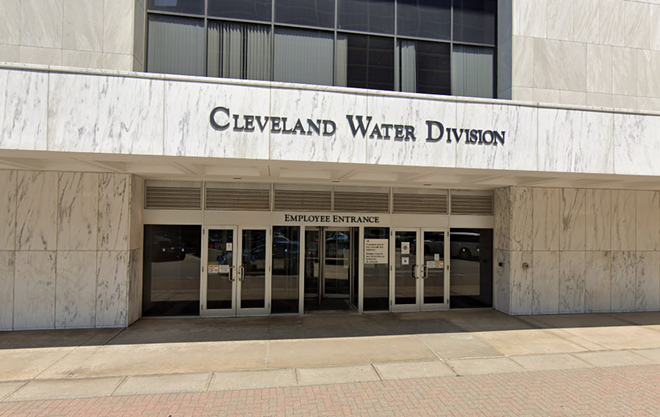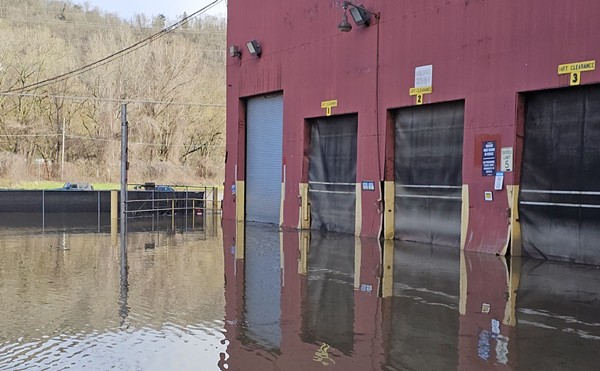Flooding, Pollution, Sprawl and Fragmented Governance — Northeast Ohio’s Water Systems Are Death by a Thousand Drops for Its Poorest Residents
By Hannah Lebovits on Fri, Aug 28, 2020 at 5:00 am
[
{
"name": "Ad - NativeInline - Injected",
"component": "38482495",
"insertPoint": "3",
"requiredCountToDisplay": "5"
},{
"name": "Real 1 Player (r2) - Inline",
"component": "38482494",
"insertPoint": "2/3",
"requiredCountToDisplay": "9"
}
]
In November 2013, Cleveland Water and the Northeast Ohio Regional Sewer District split up the water and sewer bills being sent to their customers. The effort was framed as an attempt to eliminate confusion.
In July 2014, a series of storms overwhelmed the Shaker Heights stormwater sewer system to a point of disrepair. It would eventually cost the city $1 million to fix.
In May 2017, Cleveland Heights residents found out that the city’s compliance with an Environmental Protection Agency (EPA) consent decree could quadruple their sewer bills. The cost to avoid “Sanitary Sewer Overflows” would come out of customer’s pay checks.
In July 2019, the Sam’s Club and Walmart stores near the border of Parma and Brooklyn flooded. In this case, the flooding was unique: It hadn’t rained there at all.
In February 2020, a Cleveland woman named Pat showed me an outstanding sewer bill, desperate for help. The bill was up to $132, and she was starting to consider not paying the water bill so she could pay a bit of the sewer one. Hoping to avoid becoming another one of Cleveland’s 50,000 or so shutoffs, or one of the more than 10,000 homes on which the water department has placed liens in recent years, Pat was looking for assistance. “I keep trying to talk to someone,” she told me. “When they were all in one bill, I could manage it. This is too much. I don’t know what to do.”
It’s hard to imagine a connection between those things, separated by years and miles, beyond the fact that they all involve water. But they are connected, largely through Cuyahoga County’s Manifest Destiny charge to develop every square mile of land, which has altered the amount of water that moves across the area, and the impact this water has on larger systems. Rain behaves differently, lands differently and drains differently in an area nearly 100-percent developed compared to one that was 26-percent developed five decades ago.
We’ve taken Cuyahoga County and turned it into one big parking lot.
But that’s just part of the problem.
Cleveland and its inner-ring suburbs were built prior to the establishment of best practices for water and sewer planning. Wealthier communities in the outer-ring, many of which are at higher levels of elevation, have benefited from community planning efforts that have shifted the burden to other areas. Climate change has ushered in a new era of storms and overwhelming snow melts. And the federal government has significantly reduced its role in supporting urban infrastructure.
These changes have resulted in higher fees, increased flooding, more pollution, and a disproportionate effect on the area’s low-income populations.
And no one’s really in charge of fixing it.
A Fragmented Governance System
The issue isn't being ignored, per se. There are countless public officials across the county working on aspects of this and the negative effects. But no one is truly in charge, because too many people are.
There are three primary elements of the water system in Cuyahoga County: what comes out of your faucet, what goes down your drain, and what gets collected from the natural environment.
Cleveland Water, the largest supplier of the water that comes out of your faucet, draws its service from Lake Erie.
For most Cuyahoga County residents, the water that goes down your drain is processed by Northeast Ohio Regional Sewer District.
The liquids that end up in the stormwater system are generally the responsibility of the local municipality.
That's the easiest explanation.
Individual plumbing systems carry the water from Lake Erie and the cleaning plants into your home. In some areas of the county, the combined sewer system carries both sewer and stormwater liquids to the central facilities. And while cities are each responsible for their stormwater systems, cities at various levels of elevation might pollute or be polluted by others.
The Ohio Revised Code gives quasi-governmental water utility companies the capacity to place a lien on a property when the owner has a delinquent water bill. The Cleveland City Council has the power to set five-year water rate increases. The Sewer District, a quasi-governmental agency, is under a Consent Decree with the federal government to fix the combined sewer system to ensure that heavy rainfalls don't result in sewage leaks. The District also has the authority to set rates and expenses but individual cities can and have fought against these.
The Northeast Ohio Regional Sewer District is on the frontlines of dealing with that, both in providing service to a growing number of cities that contract with the NEORSD for sewer maintenance and in remediating erosion and clearing debris from streams with the $42 million or so it collects — from, on average, $5.50/month from each customer — for its Regional Stormwater Management Program. (Which, naturally, it had to fight for in front of the Ohio Supreme Court after 11 communities challenged the sewer district’s authority to charge for stormwater management, basically arguing it wasn’t their problem and they didn’t want to pay for it.)
On the public policy end, various groups are involved in elements of water policy, particularly as it relates to Lake Erie. The federal government and several state governments have various degrees of sovereignty over the Great Lakes region.
Water-related illnesses are another layer of governance. The Cuyahoga County Board of Health regularly monitors the drinking quality and some elements of the sewer system to ensure that they are free of or minimally impacted by dangerous particles such as animal feces. Another element: the massive watershed system in the county. Watersheds run throughout the county and are managed individually, collectively by the Cuyahoga Soil and Water Conservation District and the Sewer District, and, to various degrees, by the County Office of Sustainability and the Cuyahoga County Board of Health.
These various layers of governance attempt to distill different elements of the water system but in reality, they add costs and inefficiencies.And silos. These costs are transferred to residents not only in their rates and payments but in taxes and other costs. Navigating these various layers of governance also requires herculean efforts when something goes wrong, leaving massive gaps within systems.
Sprawl, Salt, and Sealants
In a natural habitat, stormwater soaks into the ground and is absorbed, to various degrees. However, when a natural habitat is eliminated and replaced by developed and impervious surfaces, most stormwater cannot soak into the ground. Instead, it runs off into areas where it can pool and drain. These locations include watersheds, home basements, and neighboring communities.
The region has built an astounding number of parking lots, roads, highways and other impervious surfaces in the last 60 years to accommodate development- though not population growth- which has drastically and fundamentally changed where and how water flows, or doesn’t flow. As that paving happened, totalling some 50,000+ square acres, undeveloped land disappeared, and so too did forests, which control stormwater at a 90 percent rate. In their place, newly paved and built-upon urbanized areas see anywhere from 35 to 55 percent of precipitation turn into runoff. And runoff, among causing other problems, can turn into flooding.
Watersheds in highly urbanized/suburbanized areas also tend to have increased levels of pollutants in their water supply. In the case of Northeastern Ohio, those pollutants are often captured in stormwater because of “urban run-off,” the process by which liquids collect the various pollutants — salt, gasoline, fertilizers, chemicals from sealants and bacteria — on impervious surfaces.
Beachwood is a city that prides itself on its 100,000 daily visitors. And with long Northeast Ohio winters, that means a lot of road salting. Add in the number of parking lots and their various coatings, along with the six watersheds that run through the city, and you have a disaster in the making: Road salt contains high levels of chloride, and large amounts of the substance can be a huge hazard to environmental integrity, especially in the Great Lakes region.
What are the trade-offs between economic development and environmental concerns? And how does a city weigh them? At least when it comes to salting, Beachwood contends there are none.
Public Works director Chris Arrietta refused to provide Scene with a specific quantity for their yearly salting efforts. In response to my query and my direct request for an accounting of the balance between environmental protection and economic activity, he said, “We draw businesses and residents to Beachwood because of the quality services we provide; there are no trade-offs.”
But in a city that increased its land-use value by over $20 million in 2018 through development efforts, planning and zoning meetings rarely ask applicants to consider the environmental impact of new projects. A review of city minutes indicates that additional parking lots and other additions to impervious surfaces are often approved without scrutiny. The city, known for its efforts to actively poach businesses from surrounding neighbors who then build new structures in Beachwood, seems to do so with little consideration about the ways these efforts can impact those downstream.
This is especially concerning when considering that neither the state of Ohio nor any of the cities in Cuyahoga County have banned coal-tar sealants, a controversial substance that's been tied to cancer risks. Cities across Michigan, Illinois, and Wisconsin — our Great Lakes neighbors — have banned the substance.
Joe Ciuni, the Cleveland lead for the national GDP group — a contract municipal engineering outfit — told Scene that coal-tar based sealants are not often used in local projects. Ciuni assured me that no one has used coal tar in “twenty years.” A bit of digging however, reveals that companies in the area regularly advertise coal-tar products for cracks in parking lots and private driveways.
In a conversation with Scene, Beachwood city council member Eric Synenberg could not recall whether the city had a policy in place to mitigate these concerns.
Arietta further argued against a question regarding whether urban run-off is a rising concern by stating that, “No, not typically, because each new development is required to install and maintain stormwater controls on their property.” Synenberg did note that there is a local concern related to flooding and that he hears from residents when major storms hit. But rather than attribute the flooding to over-development, he placed the blame on other sewer systems that are smaller and not as well-maintained as Beachwood’s.
But whether Beachwood wants to admit it or not, it's actually more likely that it’s the other way around — that they are the cause of flooding concerns to other communities. Beachwood sits at one of the highest elevation points in the county and over six watersheds. Cities at lower levels of elevation are forced to deal with and pay for their overdevelopment.
Like what happened with the July 2014 storms that overwhelmed the Shaker sewer system.
At the time, then-mayor Earl Leiken argued that the issue did not belong to Shaker Heights alone, citing the elevation levels in Beachwood (about 150 feet above Shaker) as a source of stormwater run-off in the inner-ring suburb. The concern has only exacerbated in the past five years, as climate change ushers in more wicked storms and the decreasing population means the city has just as many sewers to manage with fewer tax dollars.
Shaker has been investing in “sensible salting” practices for several years now. Beachwood, again, refuses to provide a salt estimate. Beachwood’s sewer system is fairly new — the area only attained city status in 1960 — meaning it can handle the current intense level of usage. Shaker Heights, on the other hand, became a city in 1931.
Moreover, Beachwood sits within several watersheds, all of which could potentially provide natural draining services. The Doanbrook Watershed, though only slightly connected to the Beachwood municipal boundaries, is one of the largest watersheds in the county and made national news when it served a key role in the national narrative to protect the environment from overdevelopment, including freeway construction. Today, the nonprofit Doanbrook Watershed Partnership engages in clean-ups, workshops, and educational efforts in an effort to preserve its natural conditions. The natural habitats are important to the larger ecosystem, especially in a watershed like the Doan Brook which runs through a significant portion of the county and into Lake Erie. However, none of the current efforts to retain the natural fish and bug life have reached their targets and a majority of the fish habitat efforts have fallen short.
In a conversation with Scene, Victoria Mills, the executive director of the Doan Brook Watershed Partnership, was quick to state that the effects could not be tied to a single community. But she agreed that the issue cannot be divorced from what happens on land and in the built environment.
“One really simple way to look at the relationship between water quality and the landscape is that anything that happens on land is mirrored in the water quality,” Mills noted. Without the proper storm/run-off controls in place, whatever activity occurs on land- driving, building, waste build-up- will seep into the water-based natural environment. Daily life activities all contribute to the pollution of natural resources. That means that higher rates of activity result in higher levels of potential non-point-source pollution. Meaning a city with over 100,000 visitors — home to a number of schools, malls, light industrial facilities and, of course, hundreds of expensive and expansive homes — produces more than its geographic weight in pollution.
But, in an explainer provided by the city of Beachwood and Cuyahoga Water and Soil, Beachwood residents, rather than the legislators and businesses, are the ones encouraged to take care of the natural water pathways within the city limits. There is no discussion of the negative impacts of development, and no call to action for leaders to halt development or consider ways to retain and protect porous surfaces.
It should be noted that Beachwood is not alone in these practices. Cities across the county have parking minimum requirements for development and lack cohesive strategies for managing urban run-off. Like the stormwater itself, it's a regional issue that requires significantly more attention.
Weathering the Storm
Most water infrastructure in older communities — such as those in the core and inner-ring cities of Cuyahoga County — were established long before the Clean Water Act. They were not designed to mitigate pollutants or restrict the flow of pollutants into larger bodies of water.
In July 2019, the Sam’s Club and Walmart stores near the border of Parma and Brooklyn flooded. According to Parma mayor, Timothy J. DeGeeter, no rain fell in that area at the time. “They got no rain, in that location,” DeGeeter tells me, “they just got all of the water flowing from the southside.” At almost 300 feet below the elevation of Beachwood, Parma and its neighboring communities have experienced their fair share of flooding in the past few years. The seventh largest city in the state, which ranks second only to Cleveland in impervious acreage, a significant amount of Parma was built prior to the establishment of stormwater-related best practices.
However, Parma’s relative capacity has been key in enabling the city to weather these increasingly difficult storms. The city prioritized green infrastructure when they redesigned the mall. Hasmukh Patel, the city’s assistant city engineer, has been proactive in efforts to apply for federal funding, though he notes that the funding streams are tight. Indeed, according to a recent Congressional Budgeting Office report, federal support for transportation and water infrastructure has been declining since 2010, leaving cities and states to pick up the bill, though their spending has dropped off recently as well.
Twelve years ago, Parma followed in the footsteps of several neighboring cities in contracting out sewer maintenance services to Cuyahoga County. Along with 35 other Cuyahoga County municipalities, Parma has entered into an agreement with the county to enable the larger regional entity to manage its sewer lines in exchange for a fee for service.
DeGeeter sees the regional approach as key. “Development is a regional issue. We can do all the things we can in Parma,” he says, “but we have water coming into our community and going out of our community.”
But while the regional approach provides an economy of scale, it also adds additional layers to an already fragmented governance system, one in which the most vulnerable will always fall through the cracks.
Polluter Pays?
“Oh, so it’s not going to get paid?”
It’s 9:30 on a Monday evening at the Cuyahoga Community College Metro Campus. I’ve come to meet with several third-shift janitors who are struggling to pay their water and sewer bills. But there’s been a mix-up. Pat was under the impression that I was coming to help her sign up for a payment plan to pay her sewer bill. She brought a recent bill and other information, having tried previously to get approval for a program to help her pay off or be forgiven for her bill. “I went,” she tells me, “but they told me that you have to have some big problems like being blind or about to lose your house.” As she understands it, she’s ineligible to get any financial assistance. “They said they couldn’t help me. I went and applied but they didn’t pass my paper through.”
Leo hasn’t applied for a payment plan. English is not his first language, but as Leo understands it, he cannot access any additional assistance. I don’t know too much but Leo looks at me with surprise as I explain what a payment plan is and how it might work. He’s a proud homeowner but “the bills are just too much. And with the taxes, it’s way too much. It used to be one bill and now it’s too many bills,” he says, referring to the bill separation in 2013 and the shift to monthly billing in 2017. “It’s too much.” Pat agrees.
Pat and Leo are only two of the thousands of Clevelanders struggling with affordability issues. They’ve spent years in the city, working at low-wage, high-intensity jobs, yet have secured a piece of privately owned property. Their homes aren’t worth much. Leo lives in the Broadway area and Pat lives near Kinsman. But as the water and sewer bills continue to rise, they’ve been pushed further and further to the edge.
As a general assumption, those who create pollution concerns are tasked with mitigating the negative effects. And while implementation of the ideal can be difficult, it’s easy to assign the “polluter pays principle” to a direct pollutant. A massive company that poisons our water supply. A dumpsite owner who allows the spillover to make a community ill. A landlord who won’t remediate lead. But what about pollution that does not have a single driving source? Who pays for the effects of sprawl, age, and a highly-fragmented governance system?
The disparate impact is overwhelmingly felt by those with the most empty pockets and only a few valuable assets. Inner-ring suburban communities who are already hemorrhaging funds and residents. East Side residents who can’t afford to own a home in a community with newer sewers and pipes, where floods are easier to manage due to communal resources and flood insurance policies. And low-income residents live in areas where big storms not only result in power outages but can have lasting effects brought on by the development patterns of the region.
In a region that includes dozens of local communities, rainwater doesn't stop at city borders. There are trade-offs to development and with trade-offs should come considerations.
However, there remain few legal or social mechanisms in place to stop this trend or enforce regulations to redistribute power and resources to those most affected by the development practices of these communities. Cities like Beachwood, Chagrin Falls and Solon — cities that might be home to environmentally green corporations seeking to reduce CO2 emissions — are, in fact, perpetuating a system that presents a more significant threat to our sustainability: the toxic mixture of sprawl, fragmented governance, and a lack of direct support for those most impacted.
Lead and Liens
The Cleveland Public Water website boasts that, “Cleveland water is lead-free when it leaves our treatment plants.” But the phraseology is misleading. While the water that leaves the treatment plant might not have lead, the pipes that lead to individual homes often do. That is, if they’re located in older, poorer, more diverse neighborhoods in the region.
While much of the recent conversation around lead in the county has focused on lead paint — most commonly found in windows and entrance-ways — lead pipes are a major environmental justice concern in the county as well. Because, while the cost to remediate a single home is a hefty one, the price to replace all of the older piping is exorbitant.
According to the map provided by Cleveland Water, pipes in census tracts that are older and occupied by low-income residents are the ones most likely to be lead filled. Major development and renovation projects in the city of Cleveland require the replacement of old, lead piping. But those major projects are often unaffordable for most Clevelanders, and especially out of reach for Cleveland’s poorest population.
But lead is only one concern facing older, more distressed neighborhoods. Water bills can, and do, present even more significant hurdles for thousands of Cleveland-area homeowners. In 2015 alone, there were almost 50,000 water shut offs in the county due to water bill delinquencies. Even worse, a controversial policy at the state level allows water utility companies to place a lien on a home that is delinquent on its water payments. According to Cleveland Water, this process is only triggered when a user owes more than $300 in back-payments for more than 180 days. The company also claims that they use this power very infrequently, though records show that over 11,000 homes had liens placed against them between 2014-2018.
And the effects of these leins have been disastrous.
Tax foreclosures continue to increase in the county, even as mortgage foreclosures have dropped and/or stabilized. According to a 2016 report from Frank Ford, Senior Policy Analyst at the Western Reserve Conservancy, one in ten homes that were water delinquent in 2015 were in tax foreclosure the following year. Three years later, data from the Neighborhood Stabilization Team (NST) shows that of the homes that were water delinquent in 2015, almost 14% (506) were tax foreclosed within the following three years.
Some homes owed less than $100 in fees. Dozens of these homes owed only a few hundred dollars. These small amounts should signal distress- they should have been a sign that the household was in need of financial counseling and assistance. Instead, Cleveland Water effectively sold them down the river.
The company claims that they have and often utilize payment plan options to help residents pay off these delinquencies. But water bills that are past due do not include clear and accurate information about any sort of financial assistance. When a home is considered for a lien, the occupant has a right to a hearing. Yet, many are unaware of or able to engage in that process.
The policy is more than problematic and ineffective. It is discriminatory and prejudicial, according to the December 2019 NAACP lawsuit filed against Cleveland Water. In it, the group claims that the policy disproportionately and discriminatorily targets low-income and Black households. The suit was filed about six months after the release of a report that indicated that water affordability is an increasingly concerning issue for Americans of color in metro regions across the United States, including Baltimore and Cleveland.
According to the report, Cleveland’s water and sewer affordability concerns outpace those of other, comparable cities. Though water rates rose steadily from 1993-2010, a steep rise in rates occurred between 2011 and 2015. Sewer rates increased 13% per year from 2012-2016. These rates are higher than those of several other Midwestern cities, including Chicago, Milwaukee and Detroit.
Several Ohio senators have recently taken note. In early March 2020, the Ohio senate constructed SB273, an attempt to eliminate the practice. The bill has bi-partisan support but will require several months of committee work and approval by the House and Governor.
Still, the environmental justice concerns related to water and sewer systems is more than an issue of how to respond to delinquencies. We must ask ourselves why delinquencies occur in the first place. (The short answer: Because Cleveland water bills are unaffordable for a large percentage of the city.)
According to Dr. Manny Teodoro, a leading researcher on water governance, our understanding of water affordability is deeply flawed.
Teodoro, an associate professor at the University of Wisconsin- Madison, found that many low-wage Great Lakes residents work at least one day out of the month to afford their water and sewer bills. While those who live in Gates Mills, Beachwood, or Solon work half an hour or less to afford these basic needs. That’s a striking reality.
The way we often calculate affordability is through an equation that looks at average income and average costs. But this results in high levels of inaccuracy due to the fact that the variation in median household income is much wider than the variation in monthly usage/costs. In a November 2019 report from the Alliance for the Great Lakes, Teodoro notes that while the conventional measurements of affordability would suggest that Ohio’s water and sewer rates are affordable, a deeper understanding is required. When considering the current average price of water and sewer bills in Ohio, Teodoro found that, “in about 45 percent of Ohio communities, a household at the 20th income percentile must pay more than ten percent of disposable income for basic water and sewer service.”
This means that in a majority of Ohio communities (roughly 80%), paying the average monthly combined water and sewer bill requires at least eight hours of minimum wage work. Low-wage Ohioans must work at least one day out of the month just to afford access to their most basic need.
The Cleveland Water system, including the Cleveland Division of Water and the city council, currently sets rate charges based on how far people live from the central system. Teodoro suggests that a state or regional policy should set rates with an eye on affordability, rather than just spatial distance.
If implemented, the recommendation, and a slew of others, are likely to shift the state and region away from disparate water-related outcomes. But the nature of our water system makes it unlikely. Not because actors and institutions are profiting off of the practice or because they are intentionally squeezing Ohioans. But because the nature of the highly fragmented water system and the sprawling practices of the region’s most wealthy and well-connected communities has created a toxic system that slowly but surely erodes affordability, without consequence.
Towards Justice and Equity
Pat owes less than many lawyers make in an hour. “I pay as little as I can but now it’s gotten up to $132 for the sewer and I just can't pay it,” Pat tells me.
Kathy, a union janitor who brought me to the campus to meet Pat and the others, offers to take Pat downtown, or help her make a phone call, to find out if they can work out a payment plan. “I can come over and meet you and we can see if we can get you on a payment plan with the water and sewer bill. I paid a bit every month until I could pay it off.” Her tone is comforting and Pat is interested, she’s anxious to get her bill resolved.
Kathy is a leader in her union and the matriarch of a close-knit family. She knows that Leo has gotten some help with his bills in the past, though he had difficulty sharing the information. She knows at least three other janitors out of the thirty in her group are currently struggling to pay their water and sewer bills. Most are Spanish speaking. All live in the city of Cleveland, in older neighborhoods with low-value homes.
It’s not Kathy’s job to share this information. It’s not her responsibility to ensure that her fellow coworkers have access to clean water and sewer systems. She has her own family to take care of, including a daughter and several grandchildren. But her family has been through this process and she has valuable insight to share. She’s a connector and a resource for those who are struggling.
Still, the fact that she’s needed signifies a larger gap in the system of affordability and environmental justice: Not only do those who pay not contribute to the pollutants, the systems available to assist them are difficult to navigate and require extensive technical expertise. These administrative burdens are the final hurdle that residents have to conquer. It’s one of the greatest and most pressing inequities in a city where 66% of residents are functionally illiterate and huge swaths of the east side lacks access to the internet.
“I got behind about a year ago,” Pat tells me. When asked if it was because of something really awful, she shakes her head, “No. I mean something bad did happen but not something related to this.” I don’t push her for more details, but it's clear that she could have used some additional assistance, well before 9:30 on a Monday night in February 2020. It’s perhaps the most disparate outcome related to the water affordability crisis — the fact that those already struggling are the most likely to be further stressed by unaffordable bills. In fact, a past due bill should signify distress and trigger a socially supportive response, rather than a punitive one.
In a region that considers Lake Erie to be one of its most-prized gems, that considers itself to be a leader in sustainability, our conversations related to the topic remain almost entirely focused on habitat and natural preservation. Environmental justice, on the other hand, demands that we center the human experience and the interactions between humans and their environment in our conversations about sustainability.
It’s death by a thousand drops in Northeast Ohio, and the poorest and most marginalized populations are suffering the most.
Tags:
SCENE Supporters make it possible to tell the Cleveland stories you won’t find elsewhere.
Become a supporter today.
Scroll to read more Cleveland News articles
Newsletters
Join Cleveland Scene Newsletters
Subscribe now to get the latest news delivered right to your inbox.














